The thermal cameras by FLIR programs, are tremendous straightforward to make use of. We’ve got loaned them to over 7,000 prospects who’ve used them to search out areas the place warmth could also be escaping from their properties. We have put collectively a weblog that can assist you take advantage of out of those good cameras while you’ve it.
How one can get began
- You merely plug them into your cell phone.
- Which then connects the digital camera by way of bluetooth to the FLIR app that reveals the precise spots in your house the place you’re dropping warmth.
- You will want a smartphone that’s both iOS or an Android with a USB-C port (the cameras don’t work with adapters).
- When you have been despatched a wi-fi FLIR ONE Edge digital camera then you definitely solely want to hook up with it by way of Bluetooth to start out utilizing it.
- From inside your property, darker, cooler spots present the place cool air is coming in.
- From exterior your property, reds, whites, and hotter colors present the place warmth is leaking out.
You would possibly find yourself blocking significantly draughty home windows, or sealing particularly ethereal doorways.
What do the colors imply?
- Orange/yellow/white colors imply the world is heat – the brighter the colors are, the warmer the world is.
- Darkish blue/purple colors imply the world is chilly – the darker the blue, the colder the world is.
While utilizing your digital camera exterior your property…
- You need to see the chilly blue colors. This may imply your heating is being saved inside your home and you are not losing your vitality use on heating the sky.
- If you happen to see brilliant yellow/white colors in your partitions, roof or home windows, concentrate on these areas when seeking to enhance insulation.
While utilizing your digital camera inside your property…
- You need to see the nice and cozy yellow colors. This may imply chilly air is not coming in and your heating is not escaping out.
- If you happen to see darkish blue colors, concentrate on these areas when in search of draughts to plug and areas to raised insulate.
Doorways
To dam draughts on the base of your door, you should purchase a cushion draught excluder (~£7) or make one by stuffing tights with socks, rice, plastic baggage or any spare materials you’ve. If you happen to’re feeling a bit extra inventive, you’ll be able to sew materials into form and fill with no matter you’ve obtainable (this is a tutorial on making your personal draught excluder with stuff from round the home). The photographs under present a draughty door – we all know this due to the darkish blue areas across the door. The picture on the fitting is lighter in color on the base of the door the place a draught excluder (a rolled up outdated towel) has been positioned. The lighter colors present that the world is now hotter and the draught is being blocked. Straightforward treatment!
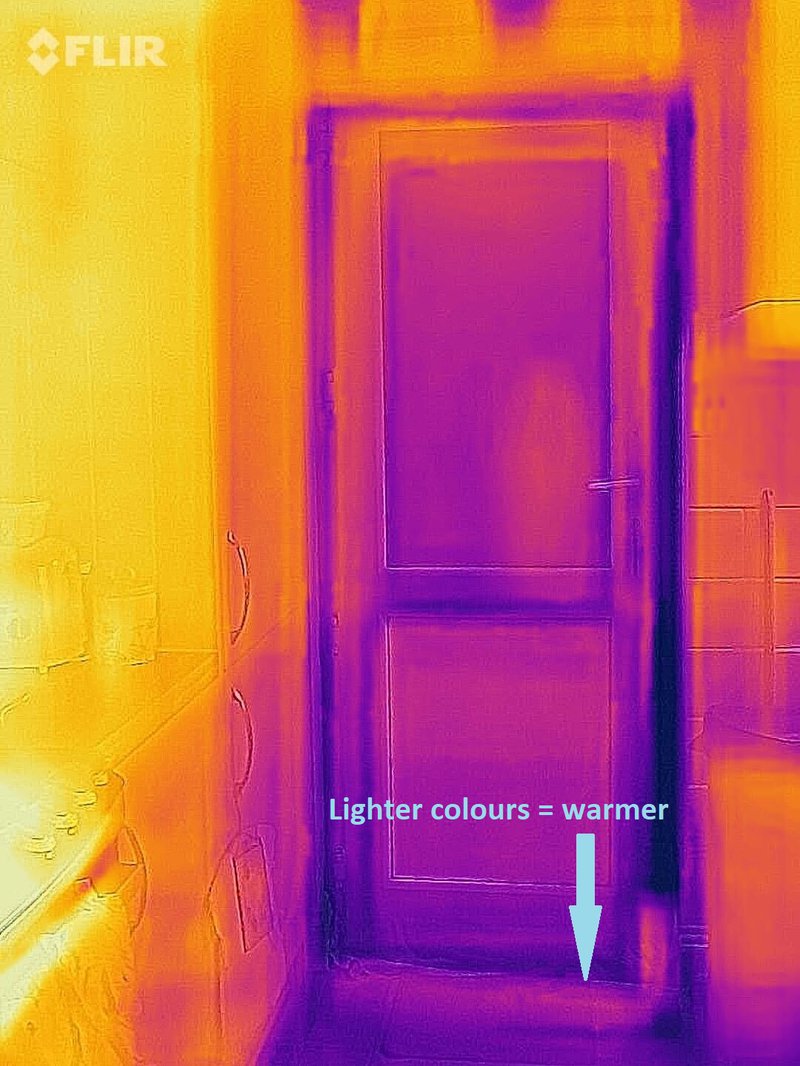
Draughty door with no draught excluder vs with a draught excluder
- If you happen to’d want a set draught excluder, you’ll be able to set up a brush strip or hinged-flap draught excluder (~£7). Here is a tutorial on methods to set up a brush strip draught excluder.
- For draughts across the edges of doorways, use self-adhesive draught-proofing strips. Foam strips are the most cost effective possibility (~£5) however might not be long-lasting. Different choices embody plastic or metallic draught-proofing strips. Here is a step-by-step information on methods to set up self-adhesive draught-proofing strips.
- Letter bins and keyholes may also be draught-proofed utilizing a metallic keyhole cowl (~£3) and a letterbox brush/flap (~£5).
- Closing curtains in entrance of exterior doorways helps to dam the chilly out and lure the warmth in. The picture under on the left has numerous darkish blue areas. This reveals that chilly draughts are coming in by gaps across the door body and the window is poorly insulated (single glazed). The picture on the fitting, with the curtains closed, is way lighter in color. This reveals that the world is now hotter because the curtain is obstructing the draughts out and trapping the warmth in.
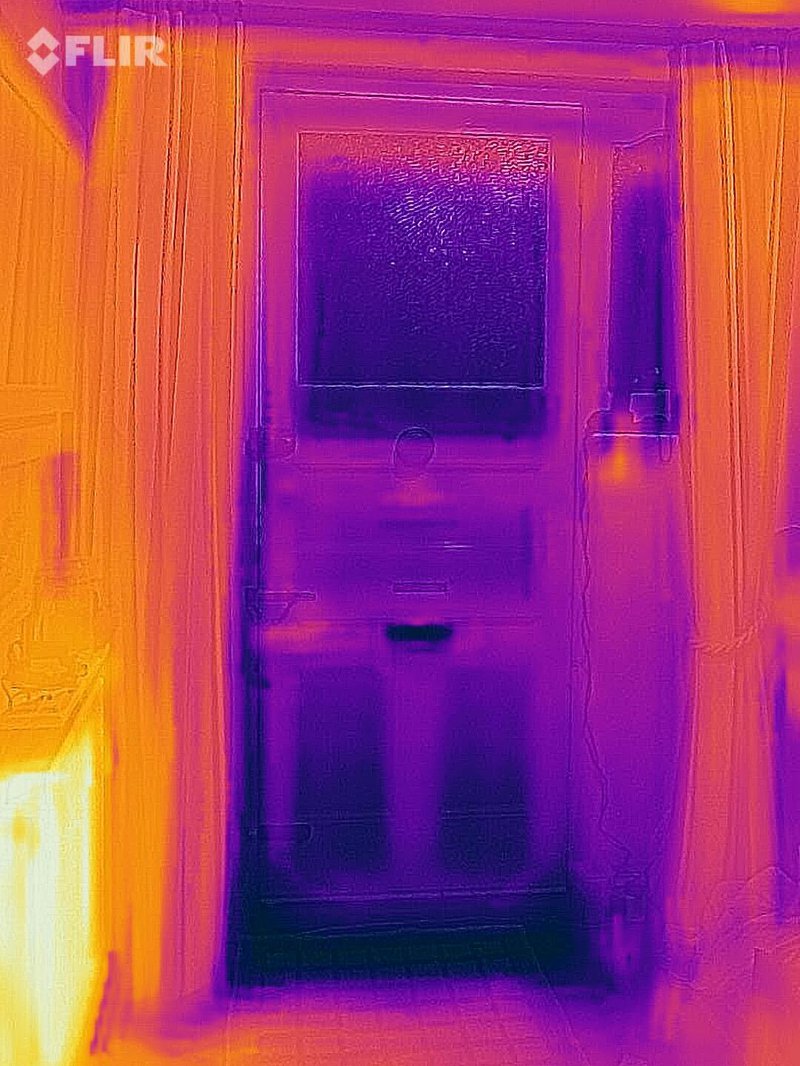
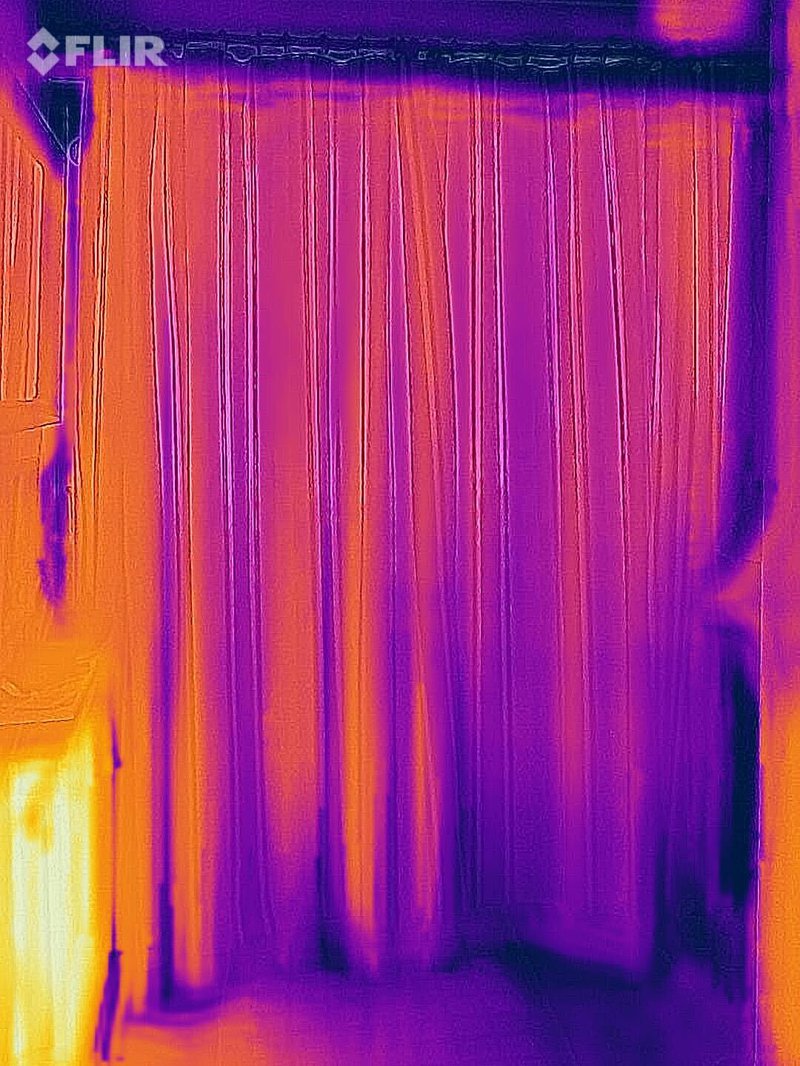
Draughty entrance door with curtains left open vs curtains closed
Unused rooms
- As warmth naturally flows from hotter to cooler areas till there’s no temperature distinction, holding the doorways of unused and unheated rooms closed, saves losing your useful heating.
- A cushion draught excluder may also be used on the base of the door.
Extractor followers
- Leaving an extractor fan on can chill your entire home, so bear in mind to show it off once you’ve completed utilizing it.
- You may get a timed extractor fan to assist guarantee it isn’t left on unnecessarily.
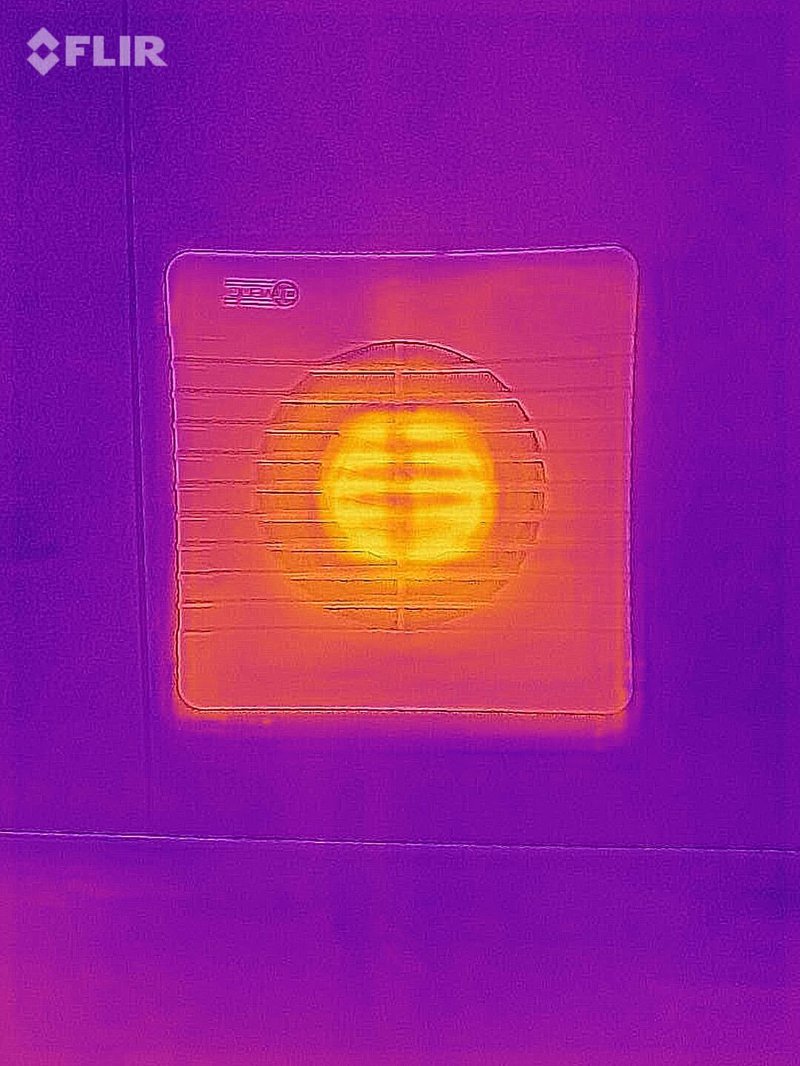
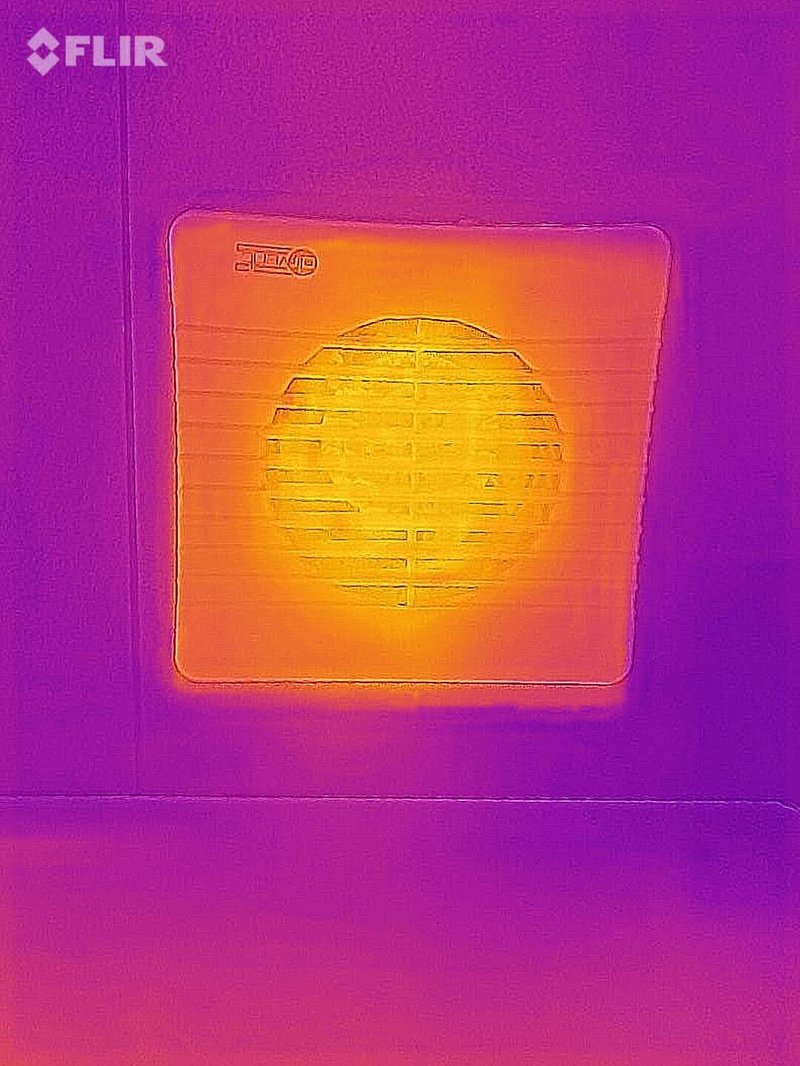
Extractor fan left on vs extractor fan turned off
Chimneys
- In case your chimney remains to be used, you should purchase or make your personal detachable hearth guard to assist cut back the draught. You simply want some spare plywood or thick cardboard lower to dimension and insulation tape/kitchen foil. While the hearth is off, match it into place in your hearth. Here is an instance of methods to make a detachable hearth guard.
- A detachable chimney balloon (£16) or a chimney draught excluder (~£22) could be positioned up the chimney to stop warmth loss while the hearth is off. If you happen to use certainly one of these, do not forget to take away it earlier than lighting the hearth!
- In case your chimney is now not used, think about having it capped by knowledgeable (~£150).
Floorboards and skirting boards
- Place a rug (or leftover cuts of carpet) over uncovered floorboards to scale back draughts by the gaps.
- Filler can be utilized to seal gaps in your flooring/round your skirting boards – it’s best to make use of filler that may tolerate motion because the boards can contract and develop.
Radiators
- Radiators want area to warmth your rooms – transfer any objects obstructing your radiators reminiscent of sofas, and guarantee curtains do not grasp in entrance of them.
- Mud that builds up between the fins of radiators makes them much less environment friendly – attempt to take away mud build-up utilizing a vacuum and radiator duster (~£5). When you have radiator covers, this is a step-by-step information on methods to take away them so you’ll be able to entry the radiator fins.
- Trapped air in radiators additionally reduces their effectivity – if there are chilly spots in your radiators, it is a signal they want bleeding to launch trapped air. Here is a tutorial on methods to bleed your radiators.
- A shelf positioned simply above a radiator helps to push warmth ahead into the room, reasonably than letting it rise to the ceiling. You could find straightforward to put in, clip-on cabinets in most {hardware}/DIY retailers.
- Insert radiator reflector panels behind radiators (simplest on radiators positioned on exterior partitions) to mirror warmth again into the room, as an alternative of letting the warmth escape out by an exterior wall.
Sizzling water tanks and pipes
- A scorching water cylinder jacket (~£15) could be fitted onto your scorching water tank to scale back warmth loss and due to this fact preserve your scorching water hotter for longer.
- Uncovered scorching water pipes may also be insulated utilizing a foam tube that covers the pipes between your scorching water cylinder and boiler.
Making modifications to your property
If chilly draughts are ignored, your heating has to work tougher to maintain you heat, rising your vitality payments and your carbon footprint… and nobody needs that. So plug these draughts and keep heat this winter!
Good to know, the federal government at the moment has a ‘Inexperienced Properties Grant’ obtainable to assist cut back family vitality use. The grant might help fund putting in double/triple glazed home windows, cavity wall insulation, roof insulation and extra.
We would like to see any nifty ideas you give you to cease these pesky draughts! Please share your photographs with us on Twitter or Instagram @octopus_energy.
Take a look at what our prospects are doing to enhance their house insulation!
Grahame had cavity wall insulation, capturing nice earlier than and after photographs. The picture under on the left reveals Grahame’s home with out cavity wall insulation. The intense colors point out that loads of his heating is leaking out by the poorly insulated partitions. The picture under on the fitting reveals Grahame’s home with cavity wall insulation. The partitions are a lot darker in color, displaying that the exterior partitions are actually colder and considerably much less warmth is escaping out into the ambiance. Cavity wall insulation can prevent as much as £160 a 12 months on heating payments!


Grahame’s home with and with out cavity wall insulation
Shanaka has made some budget-friendly insulation enhancements round his house. Take a look at his 5 easy ideas under!
Sarah has made a really helpful video on methods to use the FLIR One Edge digital camera





